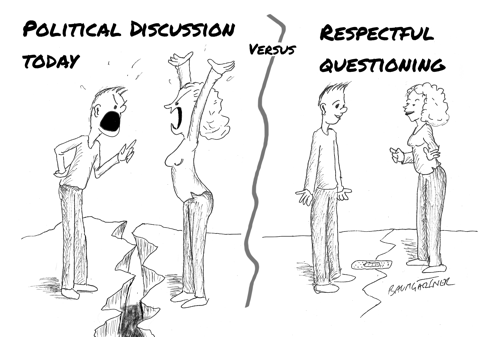
Respectful Questioning
By Jeffrey Baumgartner
Respectful questioning is a method for overcoming the divisiveness that plagues political and social debate which has largely devolved into heated arguments in which each side flings increasingly divisive and insulting statements at the each other; neither side pays attention to the other, beyond being insulted; and no one is changing anyone's minds. Indeed, research in confirmation bias has shown that even well argued statements that prove your point only cause the other side to become more entrenched in their beliefs.
Clearly, the current approach to social and political debate (if you can call it debate), is not working. So, I propose a better way: respectful questioning.
The aim of respectful questioning, on the other hand, is primarily about understanding the other side's view, values and motivations. Secondary aims are to help you understand your own view, values and motivations; to help the other side understand better their own view, values and motivation; and to find creative compromises.
The Method
The respectful questioning method is simple: ask questions. As much as possible ask open-ended questions; in other words, questions that cannot be answered with a simple "yes" or "no". You should only use closed-ended questions to seek confirmation or clarity, for example: "am I correct in understanding that you feel there should be no gun legislation in America at all?"
The best opening question in a respectful discussion is "Why?" Often, that single word question is enough to get started. If someone has just stated that gun control reduces safety, simply ask "Why?"
If possible, continue to drill down with why questions. If the other person replies, "because too many bad people have guns. So, I need a gun to protect myself and my family," ask "why?" or "Why do you think that?" Keep digging down until you cannot go any further. Then broaden your questions to explore other avenues.
If the other side says something that you vehemently disagree with, resist the urge to disagree. Instead, question her statement. If she has said something truly shocking, confirm that you understood correctly, for example: "Do I understand correctly that you believe all Belgians smell funny?" Then, follow up with questions: "Why do you believe this is so?"
Avoid questions that are judgmental, for example, "How on earth can you believe it is okay to make automatic rifles legal for anyone to buy?" Instead, just ask "Why do you believe anyone should be able to buy an automatic rifle?" Avoid asking leading questions, in other words questions that prompt a particular answer, such as "Don't you feel that if anyone can buy a gun, it will be too easy for a mass-shooter to acquire an armory?"
Keep your beliefs out of the discussion. This will make the other side feel more secure and allow them to be more open with you. If you feel it is necessary to refer to your beliefs in an issue, be sure to indicate that they are your beliefs and not the correct beliefs, for example. "I accept that gun control legislation will not end all gun crime, but I believe that it will reduce gun crime and that is better than nothing. What do you believe?"
If the other side questions your motives, be honest and tell her, "I am curious" or "I want to understand your thinking on this subject." Consider explaining respectful questioning to her and invite her to question you later.
The Rules
- You acknowledge that your primary purpose in respectful questioning is
to understand as deeply as possible the other side's view of the issue, the
logic of their view and the values that are behind that view.
- You acknowledge that your secondary purpose is to enable the other side
to understand her (or his or their, but I shall use "her") own view, the
logic that supports the view and the values that are behind the view.
- You will be polite, respectful and grateful to the other side,
irrespective of how you feel about her views. When you are finished, you
will thank her for sharing her views with you.
- You will not initiate or participate in any form of debate; nor will you
criticise the other side's views irrespective of how you feel about those
views.
- You will not promote or even share your views.
- Do not ask judgmental or leading questions.
- You will not criticise the other side's views, her explanations or -especially - her, no matter how reprehensible they or she may be.
Manners and Gratitude
While respectfully questioning, be exceptionally polite and show gratitude to the other side for sharing her views. This builds trust and sets the bar for the discussion. In most cases, you will find the other side follows your example in good manners and replies respectfully to your questions.
Manners and gratitude are critical as they build trust with the other side, especially if she knows you hold a contrary view. This, in turn, empowers her to open up more too you, which enables you to question more deeply and discover her fundamental values and beliefs.
In my experiments with respectful questioning, I have found that the respectful part has resulted in many people truly opening up and being honest with me. In a couple of instances, people I barely know have opened up about sexual abuse they suffered. When this has happened, I have expressed sadness that this has happened and gratitude that they shared such personal information with me.
Finally, at the end of respectful questioning, I always thank the other person for sharing her ideas with me.
Logic and Emotion
Some people, probably most people, tend to be emotionally driven. Others tend to be more logic driven. When an emotionally driven person discusses an issue with a logically driven person, misunderstandings easily occur. For example, I tend to be very logically driven. I prefer facts over feelings to prove a point. So, when the other side uses feelings to argue her point, I do not instinctively find it convincing. However, in respectful questioning, I have to turn off that bias and accept (even if they do not convince me) emotionally driven arguments. For example, the argument,"the only defense against a bad guy with a gun is a good guy with a gun," fails to convince me. It sounds good, but it is purely emotional. On the other hand, if you show me a survey conducted by an unbiased institute that demonstrates good guys with guns successfully intervened in potential shootings, thus saving X number of lives, that would impress me. Nevertheless, in respectful questioning, I must accept the statement and question it, for example, "In the recent Las Vegas mass-shooting, how might a good guy with a gun have made a difference?"
The issue of logic versus emotion is important to understand in respectful questioning. If you are logically driven, you may find emotional responses shallow. If you are emotionally driven, you may find logical responses shallow and devoid of feeling. Adjust your questioning accordingly. For example, in respectful questioning, I ask people how they feel about the points that they make. This can be revealing.
Creative Solutions
In two-sided respectful questioning, in which both sides of a debate respectfully question the other, there is a real possibility to find common ground, especially in values and motivation. To give an example, the gun debate in America is highly contentious, yet both sides want safety for themselves and their families. It is just that one side firmly believes that more guns leads to greater safety while the other side believes fewer guns will lead to safety. But, as long as the argument is about guns, rather than safety, it will never end.
Two-sided respectful questioning enables both sides to discover common ground, shared value and sometimes shared motivations. Once this is achieved, you can collaborate to find creative solutions. Once the two sides of the gun debate start talking about safety, I believe it is likely that solutions will be found.
Facilitated Respectful Question
If you truly want to discuss and issue and find common ground, consider running a facilitated respectful question session in which both sides agree to follow the rules of respectful questioning and a facilitator oversees the session and takes notes. In a facilitated, two-sided respectful questioning session, I recommend you toss a coin to decide who starts the questioning. Then take a half hour or so for the one side to ask the other questions. At the end of the session, take a break, then begin again with the other side asking questions.
Give It a Try
Respectful discussion is easy, but it does require putting thought into your questions. Give it a try. The next time someone says something that goes against your beliefs, do not argue. Do not stay quiet to keep the peace. Ask, "why?" and keep questioning. Do the same thing on social media as well, especially if someone posts something that goes against your beliefs. I guarantee you will learn a lot from the exercise and, I believe, the other side will too.
And, if you do give it a try, let me know what happens. I am curious!
Socratic Questioning
If you are familiar with Socratic questioning, you probably recognised aspects of it in respectful questioning. That is because I brazenly stole from the method. However, Socratic questioning is a much richer and deeper approach to enquiry and one I recommend you read up on if you are interested in questioning and understanding.
R103/20171011




